|
The Wines of Elderton, A Command Performance - Friday, 9:00AM |
ELDERTON :
2004
Elderton "Friends" Shiraz - Barossa
. Deep, dark fruit, bright with surprising
acids, quite balanced, not at all overdone. Very
nice!
1998
Elderton Shiraz - Barossa . Bit of sap and
old-viney quality to the nose and mouth. Lots
of spicy fruit in mouthfeel, beautiful balance
and flavors, smooth finish. 2 yrs in American
oak.
2001
Elderton Shiraz - Barossa . Roasted and slightly
meaty in aroma, very nice ripeness, bit of Mourvedre-like
funk to the profile.
2004
Elderton Shiraz - Barossa . Lovely nose -
lots of spice. Smooth, tasty, long well-balanced
finish. Great spice throughout - really nice!
1994
Elderton "Command" Shiraz - Barossa
. Showing some age in the overall color, and
has that American oak herbed quality. Smooth on
the palate, with lots of spicy fruit throughout.
Last vintage of 100% American oak.
2002
Elderton "Command" Shiraz - Barossa
. Lots of black fruit, slightly sappy and
herbal. A bit tart and sweet/sour in flavors,
very nice balance and finish.
2004
Elderton "Command" Shiraz - Barossa
. Wow nose, with plenty of black fruit, nice
toasty elements, lot of spice and a nice level
of ripeness. Huge spiced mouthfeel that get juicy
through mid-palate, and finished off-sweet. Wow!
2005
Elderton Fortified Vintage Shiraz - Barossa .
Late harvest Zin-like nose. Smooth and delicious,
with plenty of spice and fruit, and a bit of heat
on the back end. |
(Moderated
by John Larchet of the Australian Premium Wine (Collection
(TAPWC), this seminar gave us a look at the wines from
Elderton.)
|
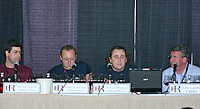
|
|
(l to r) Richard Langford, Cameron Ashmead, Allister Ashmead, and moderator
John Larchet |
Recently
named as one of the Top 100 wineries in the world by
Wine & Spirits Magazine, Elderton exemplifies Barossa
Valley winemaking at its finest. 550
growers in the area, the Barossa has two different climates
- Eden Valley and Barossa Valley. Both
have alluvial soils.
The biggest difference is that the Eden is more elevated.
Barossa viticulture emanates from the 1840s, and was
mostly settled by the Germans who were fleeing religious
pesecution. It was a tough life, and if you wanted to
eat or drink, you had to grow it. Most of the vineyards
produced fortified wine for many years, until the bottom
fell out of the market in the 1970s.
Moderator
John Larchet might as well have slept in, considering
the show Allister Ashmead put on. Articulate, knowledgeable,
and very quick-witted, Allister was constantly lampooning
his brother Cameron and had everyone in the hall in
stitches - including his brother! (By Allister's account
- and acknowledged with a nod by Cameron, this was a
apparently a common theme between the brothers, and
recently Allister found himself on the receiving end
of the barbs like "he's adopted," "good
genes have given me the beautiful looks.") Amazingly,
he spared winemaker Richard Langford.
Established
in 1979, the Ashmead family (Neil & Lorraine Ashmead)
purchased a large Barossa Estate for what was at the
time, a song, "if they bought the house, they could
have the vineyard for nothing." Apparently, the
vineyards had been in neglect for many years, so they
were just added in as part of the sale of the manor
house built by Samuel Elderton Tolley in the early 1900-1904.
The Estate was passed on from generation to generation
until the 3rd generation ran into difficulty selling
their wines and their fruit. at this time, the government
decided to pay growers to pull out their vines in the
1970s. The vineyard degenerated thereafter until the
Ashmead's purchased the land.
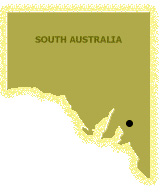 |
Allister
explained: the Ashmead's were Australian, and so had
come to wine naturally. They had recently come from
Saudi Arabia, where dad was a civil engineer for Caterpiller,
and as a result of the non-alcohol laws, were used to
"blending it up in the bathtub." After the
vineyards were brought back to their former glory, they
produced their first vintage in 1982, and their first
"Command" Shiraz in 1984. They finished building
their own winery in 2003, on a former Penfold's property
(jettisoned when Southcorp merged with Rosemount), that
was used for processing "cordials."
The
vineyard is about 72 acres of Shiraz, Cabernet Sauvignon
and Merlot in 14 blocks, with the majority of vines
between 40 and 100 years old. This age, combined with
mostly dry farming, is the basis for producing rich,
concentrated fruit. Mostly planted east to west, the
vines rows compliment the flow of the Barossa breezes.
Several of the older blocks are planted with unknown
clones, but, apparently all plantings after 1949 are
Shiraz 1654, BVRC12 or BVRC30, along with the Cabernet
Sauvignon G9V3 or LC10. The trellising used throughout
the vineyard for recent plantings is a double wire vertical
with single wire trellising used on earlier plantings.
Yields are 1-1/2-2 tons/acre. About 60-65% of Elderton
production stays in Australia.
After
an introduction by John Larchet, Allister proceeded
to introduce the rest of the panel - theouhg he needn't
have, as he obviously was the one holding court. Richard
discussed the assemblage, some Mourvedre in the "Friends"
Shiraz. Richard also described the tremendous '98 vintage
in general, and the Estate botting in particular. Notably,
the historical usage of American oak is slowly converting
to French oak. Richard has been there for three years,
and feels that smaller blocks lead to better winemaking
options.
Allister
mentioned that they machine harvest the younger vines
- whereas older vines get hand-picked. Older fermenters
(1920s), use "header boards" to keep the cap
down. Normal pump-over techniques used. Richard admitted
to "throwing a lot of oak and acid at the these
wines," "yeah, I hit 'em," he added.
Since the first in 1984, a few Commands weren't made
due to quality/quantity ('89, '91) issues. But, this
is a single vineyard (5.5 ac), one block wine that produces
excellent wine each year, and they do expect to make
it each year in the future. Richard compared it to an
adjacent block that just soesn't quite taste the same.
Richard came from Rutherglen, hence the fortified shiraz
from an older block.
Impressions:
I'd been a fan of this winery for a long time - well,
at least since the '98 vintage anyway.
The slideshow presentation on the historical aspects
was enlightening, and the brothers Ashmead (well, Al
anyway) had me laughing out loud constantly. Wonderful!
|
The
Priorat Posse - Friday, 10:30AM |
 |
|
PRIORAT POSSE:
2003
Lo Givot - Montase Nadal. Dense and brooding
in the nose, with lots of huge dark berry aromas.
Similar in mouthfeel, with cassis and mineral,
light tar and asphalt notes. 66% Grenache and
Carignan, 24% Cabernet, and 10% Syrah. The name
of the parcel means "hump of a camel."
2003
Dits del Terra - Eben Sadie. Almost pretty
nose red raspberry and something reductive. Very
juicy mouthfeel, very good balance, slightly tart/astringent
from mid-palate to finish. Grenache and Carignan
based. Less than 300 cases made. Name means "fingers
of the earth."
2004
Nit de Nin - Esther Nin. Black, plummy scents,with
red raspberry and sweet Grenach notes. Big juicy
mouthfeel, almost a bit high-toned, with light
herb and manzanilla flavors. A Grenache/Carignan
blend. Means: Night of Nin. Makes three barrels
of wine per year - from 65 yr old vines.
2004
Roquers de Porrera - Raimon Castellvi. Lots
of cassis and some whole cluster aromas - almost
like a Medoc on steroids. Wow mouthfeel, with
smooth refined tannins, very nice and juicy on
the palate - literally mouthwatering. Drop-dead
gorgeous! Blend of Grenache, Carignan, Cabernet
and Mourvedre. Moderate use of new French oak.
350-500 cases made. From 70-100 yr old vines.
2004
Mas d'en Compte - Joan Sangenis. Beautiful
perfumed nose - another wow! Sappy purple fruit,
big and chewy mouthfeel, amazing concentration
of fruit in mouthfeel, yet quite smooth. Grenache/Carignan
blend. The proverbial iron fist in a velvet glove.
Made from 100 yr old vines.
2003
Vinya del Vuit - Sara Perez and Rene Barbier.
Dusty, with touches of chalk and mineral. A bit
soft in mouthfeel - something of a junior version
of the preceeding wine in mouthfeel, with same
smoothness and refined tannins. Mostly Carignan.
2000 bottles made.
2003
Closa Batllet - Marc Ripoli. Almost
purple black fruit in aroma. A bit understated/closed
in mouthfeel, yet bigg on a Petite Sirah scale.
67% Carignan with lesser amounts of Grenache ,
Cab, and Syrah. He also makes a white using Grenache
Blanc and an indigenous variety that translates
to "chokes the old women."
2003
Clos Erasmus - Daphne Glorian-Solomon. Slightly
restrained nose of dark fruit, toast, and a touch
of chalk/mineral. Wow mouthfeel - smooth, thick
and chewy, with slight mineral quality to the
fine-grained tannins. Fantastic flavors of off-sweet
fruit, baked scone, and a touch of spice. What
seduction!
2003
Mas Doix - Ramon Llagostera. Very Bordeaux-like
nose of cassis, tobacco, and a bit of herb. Cool
climate-like pepper accents the dark fruit on
the palate, beautiful balance and finish. Very
nice. A 50/50 blend of Grenache/Carignan. Vines
planted in 1912. |
(Moderated
by Steven Olson, aka Wine Geek (fara right), and featuring
Eric Solomon..)
Three
years ago importer Eric Solomon invited HdR attendees
to Wake up and smell the Carignan! Well, Eric's back
and picking up where he left off in 2002. He had assembled
a panel of leading Priorat producers - 9 of them, to
help share his passion for the region, and further our
understanding of its wines. We were promised that the complexity and beauty
of the Priorat would be seen through the eleven villages
of the appellation, and th seminar proved to be every bit of that. Winemakers
included: Sara Perez and Rene Barbier, Marc Ripoll,
Daphne Glorian, Esther Nin, Montse Nadal, Eben Sadie,
Ramon LLagostera, Raimon Castellvi, and Joan Sangenis.
Named for the “Prior” or head of the Cartesian Monks who planted the area's original vines, Priorat
is located in Catalonia, Spain, and is mostly about altitude - the region is mostly hilly, and in the extreme north of the comarca (county) is the Montsant mountain range, rising to over 1000m. The climate is continental: dry and hot in summer, cold in the winter - perfect for grapes. There are 300 days of sunshine, and a hot temperature of about 110 degrees in the summer. Priorat has an average of 200-650
meters in altitude 15 inches of rainfall, very low yields
and incredibly steep slopes. Sharing this topography are hazelnuts, lavender and thyme - which does indeed seem to come through in the wines from these unique
microclimates.
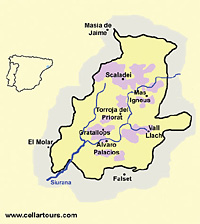 |
Priorat |
Most
of the grapes here are Garnacha (Grenache) and Cariñena (Carignan), with far lesser amounts of Cabernet Sauvignon and Syrah.
Steve Olson is ebullient about Priorat, and says: it's exotic, it's Catalonia and
it's residents are "citizens of Spain by choice."
"Spain is the new France," with 600 indigenous
grapes, #1 country in the world in total acres under
vine, #2 in per capita consumption, and #3 in production
of wine. Steve introduced Eric
Solomon, "a man that needs no introduction, but
certainly deserves one," who proceeded to tell us that back in 1990, the wines
were all sold in bulk. In '89, there were 8 wineries
- now 82 wineries - such are the changes to the area.
The theme for this seminar was, "Schist Happens," an obvious play on a common slang phrase of ours. But, Schist they do have in Priorat, and plenty of it. The hills and mountains hereabouts are composed largely of ancient compressed slate, called schist, which can run almost 100 ft deep
at points. It is in these difficult conditions that the Grenache and Carignan prosper - or more properly, struggle to produce excellent fruit.
Impressions:
what a stunning introduction to Priorat. To be able
to try these limited production wines in one sitting
was phenomenal.
|
The
Wines of Vanessa Wong, Françoise Peschon,
and Christine Vernay - Saturday, 9:00AM |
(Moderated
by John Alban, this seminar gave us a look
at the wines of Domaine Georges Vernay, Araujo, and Peay Vineyards.)
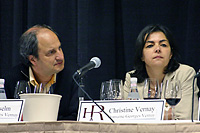 |
Paul Amsellem and Christine Vernay |
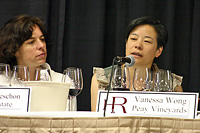 |
Françoise Peschon and Vanessa Wong |
Celebrating
the diversity that is found in Rhône wines from
around the globe is what HdR is all about. So what about
getting back to the comparisons between France and California?
Well, this seminar aimed to do that, by bringing together
three exceptional winemakers in Françoise Peschon
(Araujo Estate, Napa, CA), Vanessa Wong (Peay Vineyards,
Sonoma Coast, CA), and Christine Vernay (Domaine Georges
Vernay, Condrieu, France) for a tasting of their wines
from their uniquely different terroirs.
Translating
through her husband, Paul, Christine Vernay explained
how she never expected to be running a winery, however,
when her brothers took up other occupations, she took
the reins from her father (Georges Vernay). Georges
Vemay, now 78, dominated Condrieu in the appellation's
early days. During the 1950s, his domaine had the only
15 acres of Viognier in the appellation. That has all
changed now. With 270 acres of vines and numerous producers,
Condrieu is one of the Northern Rhône's premier
white-wine appellations. Vernay retired in 1997, and
his daughter, Christine, now handles the winemaking
while her ebullient husband, Paul Amsellem, 50, handles
the business.
DOMAINE GEORGES VERNAY :
2004
Condrieu Chaillees de l'Enfer. Fragrant nose
of light apricot, nectarine and white peach. Lovely
balance and texture, with a streak of spice that
act as the wine's backbone. Made from old vine
Viognier. The name translate to "terraces
of hell."
2001
Cote Rotie Maison Rouge . Light roast beef
quality to the dark fruit, with touches of pepper
and chalk. Very refined in mouthfeel, yet primal
as well. Very nice balance and nice grip on the
finish.
ARAUJO :
2002
Estate Syrah. Nice roasted dark berry, with
ripe aromas. Beautiful smoothness throughout.
Beautiful mouthfeel, with fine-grained textures,
excellent balance and long finish.
PEAY VINEYARDS :
2003
Estate Syrah. Cooler climate dark fruit, with
touches of pepper, floral perfume, and pomegranate.
Very smooth, intense, juicy, excellent balance,
with nice minerality and a touch of blood/iodine.
2004
Estate "La Bruma" Syrah. Seems almost
like a warmer climate nose, with more of a red
fruit profile, and almost an Aussie-like quality
of spice. Bright mouthfeel, very smooth textures
- almost Hermitage-like with smooth toasty elements
and a long fine-grained finish. Name translates
to "The Mist."
2004
Estate " Les Titans" Syrah. Even
more Aussie-like than the previous wine, this
Syrah is infused with a beautiful clove quality
that tastes gorgeous. Forward flavors, excellent
balance, juicy acids, and long finish. Named for
two old growth redwoods on the property.
|
Without
formal training, Christine, 47, is quietly pushing forward.
This former schoolteacher admits that 10 years ago she
never dreamed of being a vigneron. Today, she works
with 42 acres of vineyards-nearly half in Condrieu,
the rest in St.-Joseph, Côte-Rôtie and the
Vin de Pays des Collines Rhodaniennes-and produces about
8,000 cases annually.
Christine
only uses only 20 percent to 25 percent new wood on
her whites and likes to ferment completely dry. Consequently,
even when the wines have high alcohols and low acidities
(as in 2003), they remain lively and approachable.
Among
Vernay's several Condrieu bottlings, the top cuvée
is the Coteau de Vernon, made from the estate's original
vineyard, planted in the 1920s. There are also Les Chaillées
de l'Enfer (from a vineyard planted in 1957) and Les
Terrasses de l'Empire. All three show clean, bright,
focused eharacters in the 2003 vintage. Their elegance
is impressive, considering the opulent, tropical
fruit nature of most whites in 2003.
Françoise
Peschon began at Araujo Estate in 1993, hired by Tony
Soter, Araujo's initial consulting winegrower, as his
assistant winemaker. She became winemaker in 1996, while
Tony, along with his associate, Mia Klein, continued
as consultants until his retirement in 1998. The consistent
character of Araujo Estate wines derives largely from
Françoise's cumulative experience with the vineyard
and the wines, and her dedication to producing wines
that express the character of the vineyard.
Raised
in California with roots in Luxembourg, Françoise
received her enology degree from U.C. Davis. After postgraduate
work at the University of Bordeaux and an apprenticeship
at Chateau Haut Brion, she returned to California to
join Napa Valley's Stag's Leap Wine Cellars, where she
worked for seven years before joining Araujo.
During the seminar, looking both right and left, Françoise
made an interesting observation, as she found herself
"seated between the old world winemaking methods
of Vernay and the new world of powerpoint presentations
of Peay.
Vanessa
Wong, formerly of Peter Michael and Hirsch Vineyards,
told how many people who come to visit the Peay hilltop
vineyard immediately fall in love with the spot. She
did, too, when she came to see it for the first time,
but viewed it with a regard not just for the physical
beauty of the place, but for the magnificent vineyard
potential she immediately visualized while walking the
slopes of each vineyard block.
As a wine maker, she feels her job is to coax out and
accentuate the defining characteristics of the grapes
to produce wines of distinction. As a result, what happens
before the grapes arrive at the winery vastly affects
my ability to achieve her goals. She says she had known
for some time that the Sonoma Coast was the new frontier,
viticulturally, with its unique climate and a topography
that lent itself the crucial elements for growing grapes
for quality wine -- long sunny days, with cool nights,
and mild autumns that offer slow yet continuous ripening
seasons.
For her, one of the most important aspects of making
quality wine is growing grapes, or at least selecting
grapes from an ideal site. Factors such as average temperature,
overall heat days (days with temperature above a certain
level), soil health and drainage, sun exposure (aspect)
and others should be considered for the type of variety
grown and wine quality and style objectives. If one
starts with grapes grown in an ideal site, she says,
one is that much closer to producing a high quality
wine. Equally important to her is the meticulous and careful
cultivation of balanced vines that result in low yields,
with the ultimate objective being the production of
concentrated flavors in the grapes.
Lastly,
to bring out and retain these flavors, Vanessa says she employs wine
making practices that are minimally manipulative to
the grapes during processing and also to the wine during
its vinification and barrel aging. With this vineyard
on the Sonoma Coast, she says, she has accomplished
the crucial step of securing an ideal location, and
is able to work with husband Nick to grow balanced vines
that produce fruit of the highest quality. The difficult
growing conditions also rewards the persistent (and
stubborn) person with great fruit - in fact, Peay Vineyard
was named one of the ten
best vineyards by Food & Wine Magazine in December
of 2005. The cool climate allows them to leave the fruit
hanging on the vines quite late into the season, developing
fruit complexity without lowering the acid and raising
the sugars that occurs in warm-climate vineyards.
Impressions:
The wines were all impressive, but more than the wines,
it was apparent that each of these winemakers is at
the top of their respective game -- and will only continue
to get better with time.
|
The
Trio Infernal - Saturday, 10:30AM |
|
THE TRIO INFERNAL :
2004
"Le Grand Blanc de Revelette" Vin de
Pays des Bouches-du Rhone. Despite the best
of intentions, this wine was unfortunately corked.
2004
"La Loye" Condrieu, Dom. J-M Gerin .
Pretty, with a light minerality and stone fruit.
Very juicy mouthfeel, lots of acids, touch of
citrus, and very, very long finish.
2004
Crozes Hermitage , Dom. Combier. Beautiful
nose of rose petal and dark fruit. Roasted off-sweet
flavors, juicy, with excellent balance and long
finish. My notes say "very French."
What the heck does that mean?
2004
"Clos de Grives" Crozes Hermitage ,
Dom. Combier. Smoky and meaty in the nose,
with a warm fruit quality. Juicy and almost gamey
in flavor, starts to get a bit soft at mid-palate,
but picks up a big hit of acids on the back end.
2004
"Champin de Seigneur" Cote Rotie, Dom.
J-M Gerin . Fascinating flinty/gunpowder quality
in the nose, with lots of roasted aromas. Smooth
mouthfeel, but fairly tannic throughout. Nice.
2003
"Le Grand Rouge de Revelette" Cote de
Aix. Lots of pomegranete in the nose. Huge
mouthfeel, very juicy, off-sweet/tart flavors,
extra long finish. 50% Syrah, 30% Grenache,and
20% Cab.
2003
1/3 Trio Infernal - Priorat. Nice Grenache-based
nose. Lightly sweet mouthfeel, nice and round
on the palate, very tasty, obvious, but controlled
tannins. Real nice! 60% Grenache and 40% Carignane vines that are 12-35 years old.
2003
2/3 Trio Infernal - Priorat. Similar to above,
but nicer in the noce, and smoother and silkeier
in the mouthfeel. Seems like layers and layers
of fruit here. Very nice!
|
(Moderated
by Christophe Baron, the seminar gave us a closer look at the wines of Chateau Revelette, Domaine Jean-Michel Gerin, and Domaine Combier .)
| 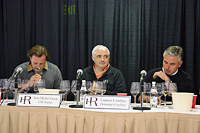
|
| (l
to r) Peter Fischer, J.M. Gerin, and Laurent Combier |
The names Gerin, Combier and Revelette are synonymous with some of the finest wines of France. In 2000, looking for a new challenge, these three friends acquired 50 acres of vineyards in Priorat, much of it
old-vine Carignan. This “Trio Infernal” has recently released their very first efforts, to great interest and acclaim. Jean-Michel Gerin (J.M. Gerin), Laurent Combier (Domaine Combier), and Peter Fischer
(Château Revelette) joined us to discuss and taste both their individual properties and that of their exciting new joint venture.
The teaming of Laurent Combier of Domaine Combier in Crozes-Hermitage, Peter Fischer of Château Revelette in Coteaux d’Aix-en-Provence, and Jean-Michel Gerin of Domaine J-M Gerin in Côte-Rôtie have created a whole that actual is larger than the sum of its parts.
Now that they have France all figured out, it was time for something new and different – how about Spain, one of them must have said, and off to Calalan they went. Apparently they drive all night to get here, and start immediately working on the vineyards, tending to about 50 acres of prime property they bought together in 2000. They do this about twice per month - but feel it’s worth it. As Gerin put it, “Priorat is like Cote-Rotie was 100-years ago.” Their vineyard gives them some very low yields, but that’s what it takes to grow great grapes – some of which is 100 yr old Carignan. Much of the soil on the property is composed of red schist, which is unique to the area.
The wines we tried were fascinating, with subtle differences, and I found myself wondering why do people who make such interesting things on their own want to get together inthe first place. As Gerin says through moderator Baron, "I felt I had gone full circle, and I needed a new challenge. I would love to make wine in Spain and compare it with Syrah from]different regions."
Impressions:
fascinating to hear about three Frenchmen starting up a project in Priorat. The driving back and forth from France to Spain reminded me of "The Wages of Sin" movie.
2006
HdR : Syrah Shootout | the
Seminars | the Auction Lots | Photo Journal |
